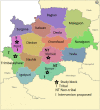Association between adverse pregnancy outcomes and preceding risk factors: a cross-sectional study from Nashik District, India
- PMID: 34663247
- PMCID: PMC8522067
- DOI: 10.1186/s12884-021-04174-w
Association between adverse pregnancy outcomes and preceding risk factors: a cross-sectional study from Nashik District, India
Abstract
Background: The preconception phase of women's life cycle is critical but comparatively ignored. The presence of health risks is judged as hazardous to the wellbeing of women and their offspring. This study aimed to estimate the prevalence of various pregnancy outcomes and assess the association between certain risk factors and adverse outcomes.
Methods: As a part of a preconception care intervention project, a baseline survey was conducted in four blocks of Nashik District, India. In this population-based cross-sectional analytical study, we compared cases in the study group (randomly selected one tribal and one non-tribal block) with those of the control group (one tribal and one non-tribal block). A comparison was also made between the tribal and non-tribal blocks in each group. All women who had a pregnancy outcome in the preceding 12 months (01 April 2017 to 31 March 2018) were interviewed. Trained Accredited Social Health Activists conducted the survey under the direct supervision of Auxiliary Nurse Midwives and Medical Officers. Multivariate analysis was carried out to find the adjusted prevalence ratio of having a particular adverse outcome because of the prespecified potential risk factors.
Results: A total of 9307 women participated in the study. The prevalence of adverse pregnancy outcomes was as follows: abortion in 4.1%, stillbirth in 1.7%, preterm birth in 4.1%, low birth weight in 13.2%, and congenital physical defect in 2.8%. Prevalence of parental consanguinity, pre-existing maternal illness at conception, heavy work during the last six months of pregnancy, tobacco consumption, alcohol consumption, direct exposure to pesticides and domestic violence during pregnancy was 18.5, 2.2, 18.7, 5.6, 0.5, 2.3, and 0.8% respectively. Risk factors associated with abortion included pre-existing illness and heavy work in the last six months of the pregnancy. Consanguinity, tobacco consumption during pregnancy and pre-existing illness were identified as risk factors for stillbirth. Significant risk factors of low birth weight were heavy work in the last six months of pregnancy, pre-existing illness and residence in a tribal area.
Conclusion: There is a need to emphasize on maternal behaviour, including tobacco consumption, and heavy work during pregnancy, as well as on parental consanguinity and pre-existing maternal illnesses, in order to achieve the best possible pregnancy outcomes.
Keywords: Abortion; Adverse pregnancy outcomes; Congenital physical defect; Low birth weight; Risk factors; Stillbirth.
© 2021. The Author(s).
Conflict of interest statement
The authors declared that there were no competing interests.
Figures
References
-
- Social Statistics Division, Ministry of Statistics and Programme Implementation, Government of India. Millennium Development Goals – Final country report of India; 2017. Available at: http://www.mospi.gov.in/sites/default/files/publication_reports/MDG_Fina... . Last accessed on 3 Jun 2020.
-
- Office of Registrar General & Census Commissioner India. Census Info. Ministry of Home Affairs, Government of India; 2011. Available at: http://www.censusindia.gov.in/2011census/HLO/HH14.html. Accessed 16 Dec 2019.
-
- Shrivastava S, Shrivastava P, Ramasamy J. Implementation of public health practices in tribal populations of India: Challenges and remedies. Healthcare in Low-resource Settings 2013;1:e3.
-
- Garikipati U, Babu GR. PantH, et al. a study of infant deaths in tribal area of Andhra Pradesh, India. Global Journal of Medicine and Public Health. 2013;2(4):1–15.
MeSH terms
LinkOut - more resources
Full Text Sources
Medical
Research Materials
Miscellaneous



